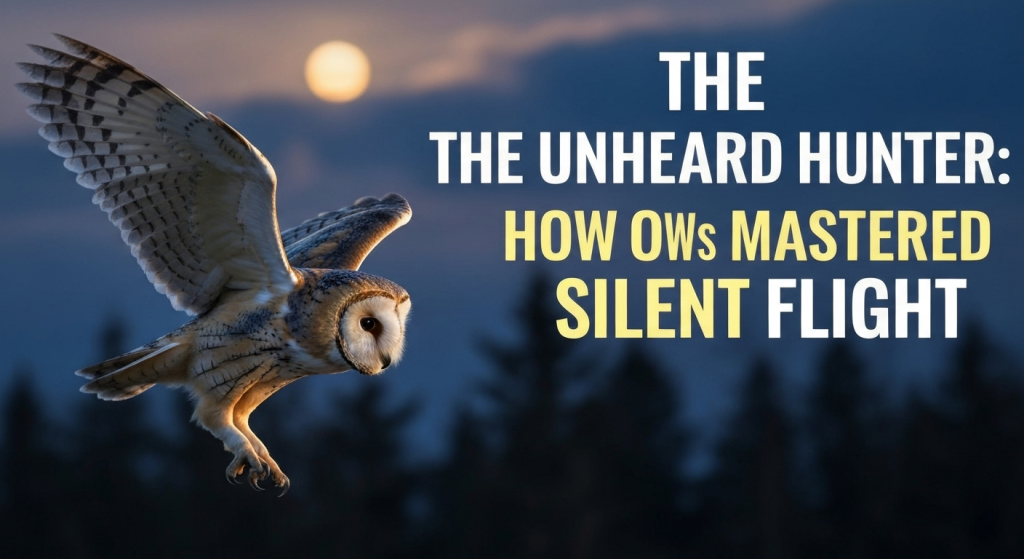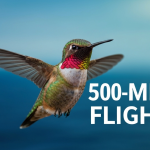Have you ever stood in the woods at twilight, feeling that profound, watchful quiet? In that silence, an owl might be gliding just feet above your head, and you would never know. Unlike the noisy flapping of a pigeon or the powerful whoosh of a hawk, an owl’s flight is a masterclass in stealth. This incredible ability isn’t magic; it’s a product of millions of years of evolution, resulting in a set of highly specialized tools that other birds simply don’t have. Understanding how they do it reveals one of the most brilliant engineering feats in the natural world.
For years, my work has involved exploring the wonders of the avian world, trying to decipher how these creatures have so perfectly adapted to their environments. My name is Mahnoor Farooq, and my passion is to translate the complexities of bird biology into clear, understandable stories. After spending countless hours in the field and poring over scientific research, the silent flight of the owl remains one of the most fascinating subjects I’ve encountered. It’s a perfect example of how a single adaptation can define a creature’s entire existence. My goal here is to break down the science behind this phenomenon, sharing insights from my experience to help you appreciate the silent hunter in a whole new way.
The Problem of Noise: Why Most Birds Can’t Fly Silently
Before we can appreciate the owl’s silence, we need to understand why most birds make noise. Flight is a noisy business. When a bird like a hawk or a pigeon flaps its wings, it’s forcing air to move quickly over and under the wing’s surface. This rapid air movement is what creates lift, but it also creates turbulence. Think of turbulence as chaotic, swirling pockets of air. This chaos is the primary source of sound in bird flight.
The main culprit is the air flowing over the front (leading) edge of the wing, which then becomes chaotic as it passes over the surface and leaves the back (trailing) edge. This turbulence generates pressure fluctuations in the air, which our ears perceive as sound—the characteristic “flapping” or “whooshing” noise. For most birds, this noise is simply a byproduct of powered flight and doesn’t interfere with their lifestyle. A pigeon eating seeds in a park doesn’t need stealth, and a hawk diving at 150 mph relies on speed, not silence. But for an owl, this noise would mean the difference between a meal and starvation.
The Owl’s Secret Toolkit: Three Feather Adaptations for Stealth
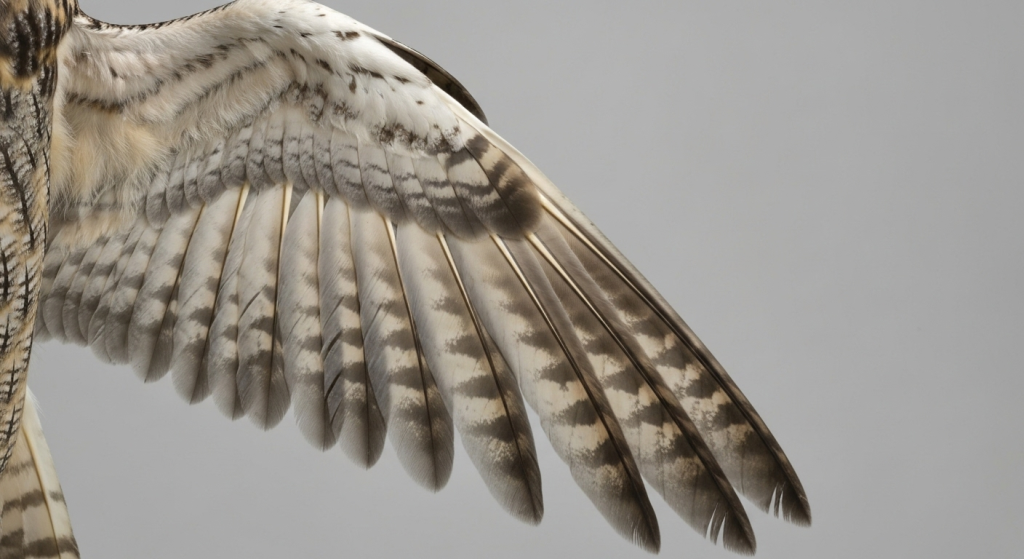
Owls have evolved a sophisticated three-part system in their feathers that systematically tackles the problem of flight noise. These adaptations work together to manipulate the airflow around the wing, smoothing it out and dampening sound before it can ever be created. It’s a system so effective that engineers are now studying it to design quieter airplanes and wind turbines.
1. Leading-Edge Serrations: A Comb to Tame the Turbulence
The first tool in the owl’s silent flight arsenal is found on the leading edge of its primary flight feathers. If you were to look closely at an owl’s wing, you would see that the front edge isn’t smooth like a typical bird’s. Instead, it has a series of tiny, stiff, comb-like serrations. I remember the first time I held an owl feather (one that was molted naturally, of course). Running my finger along that front edge was a revelation; it felt like a tiny, fine-toothed saw.
So, what does this “comb” do? It acts as a turbulence disruptor.
As air flows toward the wing, these serrations break up the single large gust of air into many smaller, gentler streams of air, often called micro-turbulences. These smaller air streams flow more smoothly over the wing’s surface without creating the large, noisy pockets of chaotic air that a smooth leading edge would. This simple yet brilliant modification tackles the biggest source of flight noise right at the point of origin. It effectively turns a loud “whoosh” into a series of tiny, almost inaudible whispers.
| Feature | Standard Bird Wing | Owl Wing |
| Leading Edge | Smooth and uniform | Serrated, comb-like structure |
| Airflow Interaction | Air hits a solid edge, creating large, noisy turbulence. | Air is broken into smaller, quieter micro-turbulences. |
| Acoustic Result | A distinct “whoosh” or flapping sound. | Sound is drastically reduced at the source. |
This adaptation is a perfect example of a small structural change having a massive acoustic impact. It’s the owl’s first line of defense against creating noise.
2. Trailing-Edge Fringe: A Muffler for the Air
Once the air has passed over the top and bottom of the wing, it must rejoin at the back. On a typical bird’s wing, the trailing edge is relatively sharp and stiff. When the two streams of air meet again, they collide, creating more noise. This is where the owl’s second secret weapon comes into play: a soft, porous fringe along the trailing edge of its flight feathers.
This fringe looks like the frayed end of a piece of cloth. It’s flexible, soft, and permeable. Its function is to allow the air flowing over the top and bottom of the wing to merge back together gradually and smoothly. Instead of a sharp collision, the air streams mix gently through the soft fringe. This process effectively muffles the sound, much like how sound-dampening panels in a studio absorb sound waves to prevent echoes.
How the Trailing Fringe Works:
- Reduces Pressure Fluctuations: The fringe smooths out the pressure difference between the air above and below the wing as it merges, which is a major source of aerodynamic sound.
- Dampens Sound Waves: The soft, porous nature of the fringe physically absorbs sound energy, preventing it from propagating.
- Breaks Up Sound Coherence: The irregular structure of the fringe ensures that any remaining sound waves are scattered and disorganized, making them far less perceptible.
During my time observing barn owls for a local conservation project, I often watched slow-motion videos of their flight. You can visually see how the air seems to flow off the back of their wings with none of the sharp, turbulent patterns you see with hawks or crows. That’s the trailing-edge fringe working its magic.
3. Velvety Down Surface: The Ultimate Sound-Proofing
The third and final piece of the owl’s silent flight puzzle covers the entire surface of the wing. Most bird feathers have a relatively smooth, hard surface. When they flap their wings, these feathers rub against each other, creating a rustling or swishing sound. Owls, however, have feathers with a unique, velvety pile on the upper surface. This dense, soft down creates a sound-absorbing layer.
This velvety texture serves two key purposes:
- Absorbs High-Frequency Sound: It traps and absorbs the noise generated by the feathers themselves as they bend and brush against one another during flight. This is particularly effective for the high-frequency sounds that small mammals, like mice, are most sensitive to.
- Smooths Surface Airflow: The pile also helps to smooth the flow of air directly over the wing’s surface, further reducing sound generation in a way that complements the work of the leading-edge serrations.
Think of it like the difference between rubbing two pieces of smooth plastic together versus two pieces of velvet. The plastic creates a sharp, noticeable sound, while the velvet is almost silent. This is precisely the principle the owl’s wing surface employs. This adaptation ensures that even the minor sounds of the wing’s own movement are silenced.
The Hunter’s Edge: Why Silence is a Superpower
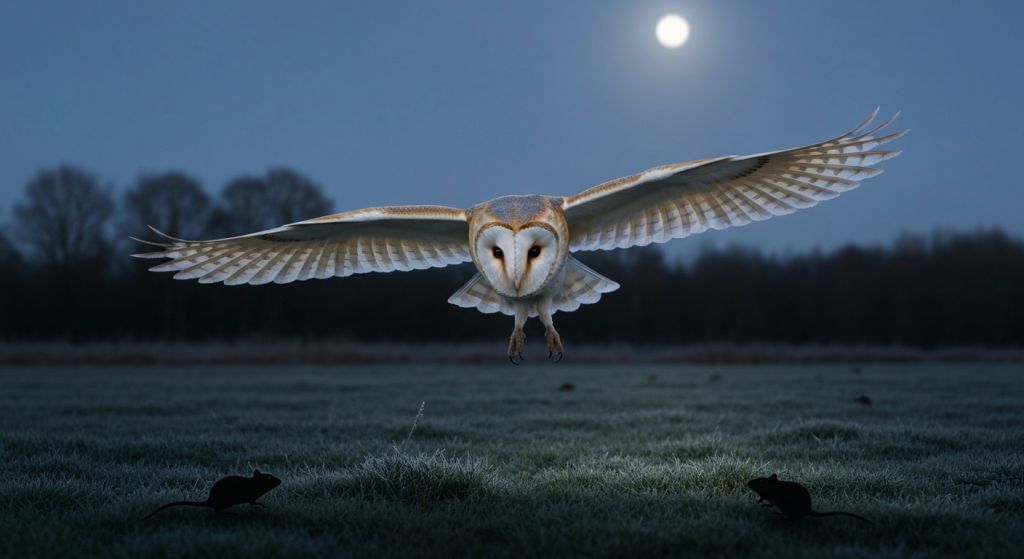
These three complex adaptations give the owl two distinct but related advantages in its hunt for prey. It’s not just about sneaking up on its next meal; it’s also about being able to listen for it.
Advantage 1: The Element of Surprise
The most obvious benefit of silent flight is stealth. An owl’s primary prey consists of small mammals like mice, voles, and shrews. These animals have incredibly sensitive hearing, evolved specifically to detect predators. A mouse can hear the faintest rustle of leaves or the snap of a twig from a significant distance. If an owl made the same amount of noise as a crow, its prey would be alerted and hidden long before the owl could even get close.
By flying silently, an owl can approach completely undetected. The prey has no auditory warning that a predator is swooping down from above. This element of surprise is crucial for a hunter that relies on precision strikes in low-light conditions.
Advantage 2: Unobstructed Hearing
This second advantage is just as critical but often overlooked. By eliminating the sound of its own flapping wings, the owl keeps its own hearing sharp and unobstructed. The loud “whoosh” of wings would temporarily deafen a bird to the subtle sounds on the ground below. Since an owl’s hearing is one of its primary hunting tools—many species can locate prey in complete darkness by sound alone—it cannot afford to have its senses drowned out by its own noise.
Silent flight means the owl can fly and listen simultaneously. It can track the faint rustling of a mouse in the undergrowth while it is on the move, adjusting its flight path in real-time based on the auditory information it receives.
| Hunting Strategy | Diurnal Raptor (e.g., Red-Tailed Hawk) | Nocturnal Raptor (e.g., Barn Owl) |
| Primary Senses | Vision | Hearing and Vision |
| Flight Style | Powerful, fast, and often noisy. | Slow, deliberate, and silent. |
| Hunting Tactic | Spots prey from a great height and dives at high speed. | Flies low and slow, listening for prey movement. |
| Key Advantage | Overwhelming speed and power. | Complete stealth and superior hearing. |
The Evolutionary Trade-Off: Why Hawks and Eagles Stay Noisy
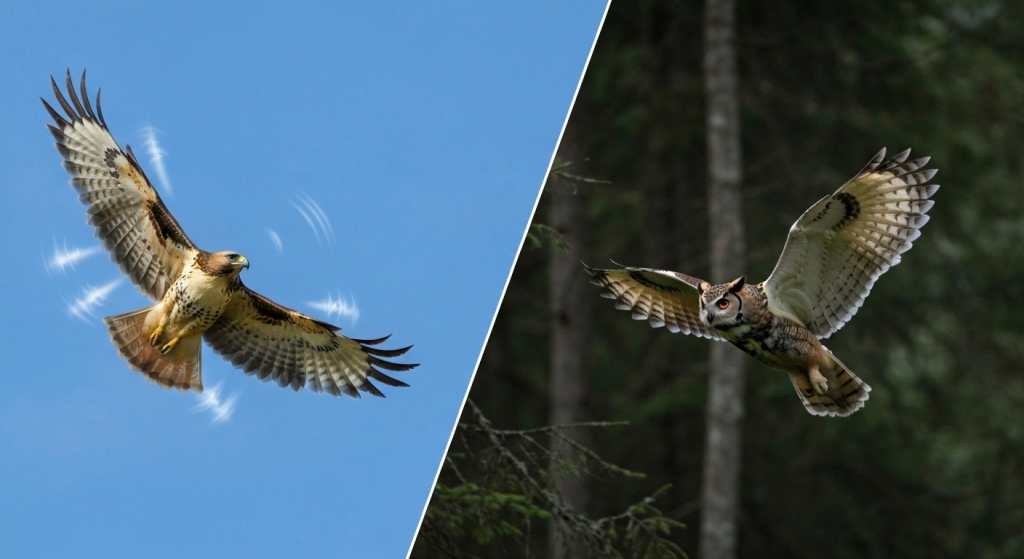
If silent flight is such a powerful advantage, why haven’t other birds of prey, like hawks and eagles, evolved the same traits? The answer lies in an evolutionary trade-off between stealth and speed.
The soft, fringed, and velvety feathers of an owl are not as stiff or durable as the feathers of a hawk. This means they are not as efficient for generating high-speed lift or for withstanding the aerodynamic forces of a high-speed dive. An owl’s flight is slow and deliberate, perfect for a low-altitude stealth hunt, but it could never catch a swift bird mid-air like a Peregrine Falcon can.
- Owls chose stealth: Their adaptations make them the ultimate silent hunters but limit their top speed and agility.
- Hawks and Falcons chose speed: Their smooth, stiff feathers allow for incredible velocity and acrobatic flight, but they are noisy.
Each type of raptor has evolved a flight system perfectly suited to its specific hunting niche. There is no single “best” design; there is only the best design for a particular lifestyle. The hawk’s noisy power is just as effective for its needs as the owl’s silence is for its own.
Frequently Asked Questions (FAQs)
Are all owl species silent flyers?
Most nocturnal owl species, like Barn Owls and Great Horned Owls, are masters of silent flight because they hunt in darkness where stealth is paramount. However, some diurnal (day-active) owls, such as the Northern Hawk Owl and the Snowy Owl, have less pronounced silencing features. Since they often hunt by sight in brighter conditions, their need for absolute silence is reduced.
Can humans learn from owl wings to make technology quieter?
Absolutely. This field is called biomimicry. Engineers are actively studying owl wing aerodynamics to design quieter fan blades, wind turbines, and even aircraft landing gear. By replicating the leading-edge serrations and trailing-edge fringe, they hope to reduce noise pollution from many sources.
Does getting wet affect an owl’s silent flight?
Yes, it can. The delicate structures responsible for silent flight, especially the velvety down and the soft fringe, can become matted and stiff when wet. A rain-soaked owl is a much noisier flyer and, therefore, a less efficient hunter. This is one reason why many owls will seek shelter during heavy rain.
Which owl is considered the quietest?
The Barn Owl (Tyto alba) is often cited as the gold standard for silent flight. Its feathers have some of the most highly developed silencing structures, making its flight virtually undetectable even to the most sensitive microphones.
Conclusion: Nature’s Silent Engineer
The next time you see an owl, whether in a documentary or as a fleeting shape in the twilight, take a moment to appreciate the incredible technology at play. An owl’s wing is not just a tool for flight; it is a finely tuned acoustic device engineered by evolution to conquer the darkness. Through a combination of a serrated leading edge, a fringed trailing edge, and a sound-absorbing surface, the owl has solved a complex aerodynamic problem that human engineers are still trying to perfect. It is a beautiful and humbling reminder that in the quietest moments of nature, the most sophisticated designs are often at work.
